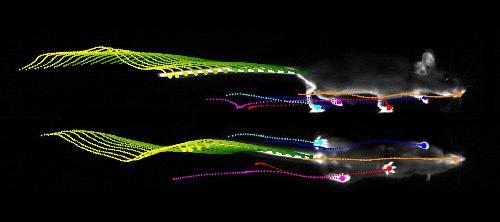Gymnastic feats like balance beam routines clearly require a great deal of coordination. But even seemingly trivial actions such as crossing stepping-stones on a river or just walking in a straight line require these very same skills. The group of Dr. Megan Carey, principal investigator at Champalimaud Centre for the Unknown, has developed a novel tool to investigate how the brain generates coordinated movement.
"People who suffer damage to a part of the brain called the cerebellum display impairments in walking and other activities that require balance and coordination", explains Dr. Carey.
To gain deeper understanding into these problems, many studies use genetic model systems such as mice.
"Mice with cerebellar damage exhibit similar symptoms to those of human patients," says Carey, "and they offer powerful genetic tools that enable us to investigate the neural circuits that underlie these problems."
However, until now it has been difficult for researchers to measure specific deficits of coordination in mice. This obstacle was recently overcome by a team of researchers - namely, Ana Machado, Dana Darmohray, Dr. João Fayad and Dr. Hugo Marques, led by Carey - who combined engineering, computer science and biological approaches to develop LocoMouse, a tool that tracks the fine details of locomotion in mice.

LocoMouse digitally isolates the mouse's paws, tail and snout to create non-invasive, detailed tracking of these key body parts over time. Credit: Megan Carey
"We developed LocoMouse as the first step in our large-scale project to reveal the neural circuits that generate coordinated walking, for which the lab has recently received significant support for from the European Research Council," says Dr. Carey.
Using LocoMouse, the researchers analyzed locomotion in mice with cerebellar degeneration, and were surprised to discover that many of the mouse's movements were unexpectedly intact. For instance, in contrast to previous findings, the forward movements of individual paws in the mice with cerebellar degeneration were indistinguishable from those of unaffected mice. Instead, the researchers found that motor deficits were restricted to coordinated movements - those that required the ability to predict and compensate for movements taking place across the body. They report their findings in a new study in the journal eLife.
The team is now using LocoMouse to explore the relation between the activity of neurons in the cerebellum and the generation of coordinated movement. They are doing this by recording neural activity in behaving animals and also by using genetic and optical tools to manipulate neural activity and investigating the effects on behavior.
Finally, while the researchers initially developed LocoMouse to investigate the role of the cerebellum in coordination, they hope the tool will be useful for researchers interested in locomotion and motor control in general. "We are making the tracking code freely available, and we tried to keep it flexible, so that anyone who wants to use it will be able to easily capture the aspects of movement they find most interesting," concludes Dr. Carey.





Comments